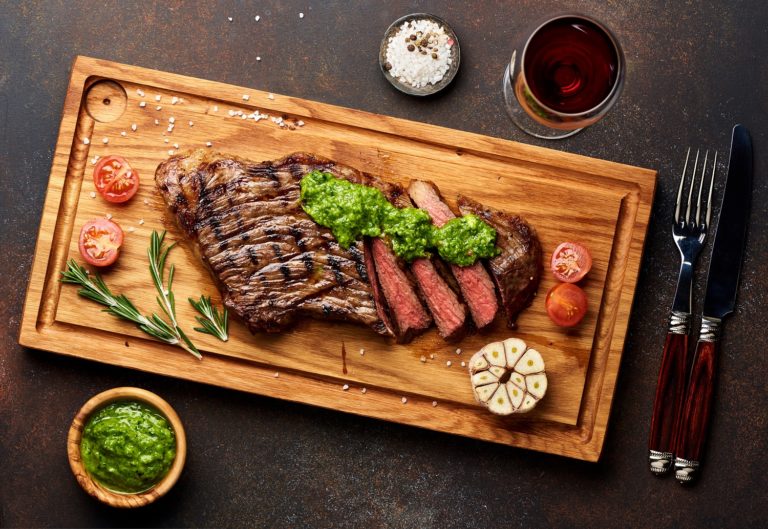
Spring Grilling
Culinary Culture
Learning
Recipes
In Argentina, mostly all meat is grass-fed, which results in leaner, healthier cuts of beef. Chef recommends selecting a cut such as flank steak that is at least 1.5” thick. Thicker cuts allow you to develop flavors on the grill for longer periods of time, resulting in a higher-quality flavor. The key of this dish is to enhance the natural flavors in the cut of meat you have selected. To do so, you must use very simple ingredients so as to prevent from masking or overpowering the flavor of the meat. Marinating the meat for this recipe is not necessary, as the slow-grilling technique tenderizes the meat. There are a number of techniques used to properly pay respect to the ingredients you have selected and give them authentic Argentinian flavors.
Allow the steak to come to room temperature before grilling. This will allow for more even cooking. Select a nice hardwood charcoal, such as applewood, hickory or a blend of the two. Start by making a large pile of charcoal to one side of the grill, and let it get glowing red. There should not be any black bits remaining, because it will give your meat an undesirable flavor. You never want flames to touch the steak.
The most important part of the grilling process is the first contact the steak makes when touching the grill. That first sizzle creates a thin brown crust which continues to develop throughout the cooking process. Please note: There is a huge difference between char-grilled flavor and charred, burnt flavor.
Place your steak and an assortment of peppers and onions on the side of the grill without charcoal. Chef leaves the top off of the grill for the cooking process because the hardwood gets extremely hot and you can visually see and control any flare ups. Keep a spray bottle of beer next to the the grill to help with flare ups. Let your steak and vegetables slowly develop flavor. The steak should not be turned until you see juices coming from the top of it.
Once you flip the steak, top it with some lemon wedges and let if finish cooking. The lemon imparts a very nice flavor and acts as a tenderizer that helps cut through the fat of the beef. When the steak and vegetables are ready, you must give the meat a chance to relax and re-absorb all of its juices. Sprinkle the steak with sea salt and let it rest, this process takes about 10 minutes. During this time, set the table and cut some lemon wedges to serve with the steak. Chef always serves this steak with a fresh herb chimichurri. Put this on top of the meat as a final touch before eating.
By keeping the condiments and sauces simple, you put the meat front and center, rather than masking it with strong flavored sauces. Prepare this sauce at least two hours prior to serving to allow the flavors to infuse properly.
To serve, slice the steak across the the grain and spoon the chimichurri over the top. The grilled peppers and onions are a great accompaniment to the steak, as well as a simple salad of greens and tomatoes. Chef suggests pairing this meal with a nice Argentinian Malbec, such as the 2016 Layer Cake Malbec from Mendoza, Argentina.
Chefs Recipe for Chimichurri Asado
Main Ingredients
Grilled beef flank steak (grass-fed organic, if possible) and lemons. See preparation and instructions above.
Chimichurri Sauce:
Yield: 2 cups
2 cups chopped parsley
4 Tbsp. chopped oregano
4 minced garlic cloves
¼ cup red wine vinegar
1 cup olive oil
1 tsp. salt
1 tsp. crushed red pepper
Cracked black pepper to taste
Combine vinegar, salt, black pepper, garlic, and crushed red pepper in a medium bowl and let stand for 8-10 minutes. Stir in parsley, and oregano. Whisk in oil.